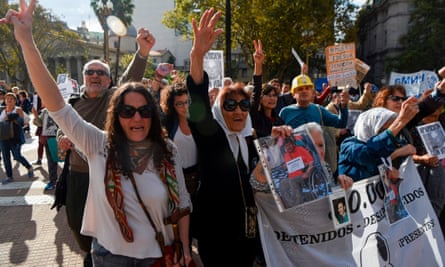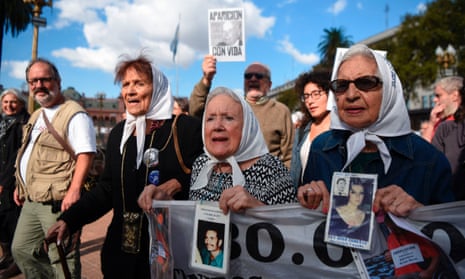Haydée Gastelú was among the first to arrive. “We were absolutely terrified,” she recalls.
On the afternoon of 30 April 1977, 14 courageous women set aside fear – and their families’ warnings – and left their homes to confront the dictatorship that had stolen their children.
That day marked the first weekly march by the mothers of Argentina’s “disappeared” against the military commanders who had planned the systematic murder of thousands.
Four decades on and 2,037 marches later, the mothers are still marching, though some of them must now use wheelchairs.
The mothers’ white headscarves became a symbol of courage and the relentless battle for justice – and they have largely succeeded in their original aims: as of 2016, more than 1,000 of the dictatorship’s torturers and killers had been tried and 700 sentenced.
But the mothers – most of them now in their late 80s – warn that the current era of alternative facts and revisionist history poses a new kind of threat for the country.
“Argentina’s new government wants to erase the memory of those terrible years and is putting the brakes on the continuation of trials,” says Taty Almeida, 86, whose 20-year-old son, Alejandro, disappeared in 1975.

“This struggle began when we were in our 40s. Now, 40 years later, we have to start all over again.”
These days, the mothers are hailed as human rights champions around the world and feted by the likes of Pope Francis and the former United Nations secretary-general Ban Ki-moon.
Forty years ago, however, they couldn’t even get their neighbours to hear their plight. The mainstream press was silent, and a large segment of the country sympathized with the dictatorship.
“People were scared,” recalls Gastelú, now 88. “If I talked about my kidnapped son at the hairdresser or supermarket they would run away. Even listening was dangerous.
“But I couldn’t keep quiet. We needed everyone to know, even if nobody believed us. That’s probably why they called us the Mad Mothers at first,” she says.
“Of course we were mad,” Almeida says. “Mad with grief, with impotence. They took a woman’s most precious gift, her child.”
At the time, the women couldn’t gather in groups of more than three or four if they wished to avoid arrest. Instead, they marched two by two, around the Plaza de Mayo in front of the presidential palace every Thursday at 3.30pm.
Like thousands of other young people who were forcibly “disappeared” during the dictatorship, Gastelú’s son Horacio – a biology student – was not actively involved in politics when he was seized by a group of armed men in August 1976 and disappeared without trace.
It took another 24 years before forensic anthropologists confirmed that he was one of 30 youths murdered by the army in revenge for the assassination of a general by leftwing guerrillas.

After staging a coup in 1976, the military rapidly put into action a plan to crush any potential opposition, eventually murdering some 30,000 people – almost all of them unarmed non-combatants.
But in recent months the historical consensus over the 1976-1983 dictatorship has been challenged under Argentina’s current centre-right president, Mauricio Macri.
His government suggests that the number of victims may have only been around 9,000, citing a provisional figure drawn up by a special commission after the return of democracy in 1983. But the military themselves reported killing 22,000 people in a 1978 communication to Chilean intelligence.
The Mothers of Plaza de Mayo – aware that their watch is drawing to a close – are deeply concerned by efforts to whitewash history – in Argentina and around the world.
“Among us there are mothers who escaped from the Nazi Holocaust, only to lose their Argentinian-born children to another dictatorship – so we know for a fact that these tragedies can repeat themselves,” Gastelú says.
“The Argentine military took lessons from the Nazis,” says Sara Rus, a 90-year-old Auschwitz survivor who settled in Argentina after the second world war – and whose son, Daniel, was killed by the military in 1977.
“I don’t even have his bones to bury,” says Rus, originally a Polish Jew from Lodz who still speaks Spanish with an accent.
And the mothers are painfully aware of the risk that can face those who speak out against tyranny. In December 1977, three of the group’s leaders – along with two French nuns and seven young helpers – were abducted in a series of coordinated raids. All 12 were drugged and loaded on to aircraft – then thrown unconscious but still alive into the freezing waters of the South Atlantic.
Robbed of their original leaders, the mothers fell under the sway of Hebe de Bonafini, an energetic and highly politicized woman who had lost two sons to the dictatorship and who prioritized political aims over the search for truth and justice. The mothers eventually split into two groups.
Bonafini’s group, while still active and important today, became embroiled in a corruption scandal during the government of former president Cristina Fernández de Kirchner that discredited her cause in the eyes of many.
Despite the split, the Mothers of Plaza de Mayo can look back with some satisfaction at the work accomplished.
A sister group – the Grandmothers of Plaza de Mayo – grew up alongside the Mothers, and have also had success tracking down the children of women who were abducted by the dictatorship while pregnant.
The young women were murdered shortly after giving birth and their babies handed over to military couples to raise as their own.
On Tuesday the Grandmothers announced that DNA had confirmed the identity of another victim – the 40-year-old son of two desaparecidos – Enrique Bustamante and Iris Nélida García Soler – bringing the number of “recovered grandchildren” to 122.
“We know that because of our age we will probably not live to see every single culprit condemned,” says Taty Almeida. “But though we may need wheelchairs and walking canes today, for the time being the Mad Mothers are still around.”
